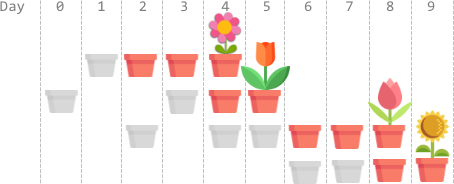You have n flower seeds. Every seed must be planted first before it can begin to grow, then bloom. Planting a seed takes time and so does the growth of a seed. You are given two 0-indexed integer arrays plantTime and growTime, of length n each:
plantTime[i] is the number of full days it takes you to plant the ith seed. Every day, you can work on planting exactly one seed. You do not have to work on planting the same seed on consecutive days, but the planting of a seed is not complete until you have worked plantTime[i] days on planting it in total.
growTime[i] is the number of full days it takes the ith seed to grow after being completely planted. After the last day of its growth, the flower blooms and stays bloomed forever.
From the beginning of day 0, you can plant the seeds in any order.
Return the earliest possible day where all seeds are blooming.
Example 1:

Input: plantTime = [1,4,3], growTime = [2,3,1]
Output: 9
Explanation: The grayed out pots represent planting days, colored pots represent growing days, and the flower represents the day it blooms.
One optimal way is:
On day 0, plant the 0th seed. The seed grows for 2 full days and blooms on day 3.
On days 1, 2, 3, and 4, plant the 1st seed. The seed grows for 3 full days and blooms on day 8.
On days 5, 6, and 7, plant the 2nd seed. The seed grows for 1 full day and blooms on day 9.
Thus, on day 9, all the seeds are blooming.
Example 2:

Input: plantTime = [1,2,3,2], growTime = [2,1,2,1]
Output: 9
Explanation: The grayed out pots represent planting days, colored pots represent growing days, and the flower represents the day it blooms.
One optimal way is:
On day 1, plant the 0th seed. The seed grows for 2 full days and blooms on day 4.
On days 0 and 3, plant the 1st seed. The seed grows for 1 full day and blooms on day 5.
On days 2, 4, and 5, plant the 2nd seed. The seed grows for 2 full days and blooms on day 8.
On days 6 and 7, plant the 3rd seed. The seed grows for 1 full day and blooms on day 9.
Thus, on day 9, all the seeds are blooming.
Example 3:
Input: plantTime = [1], growTime = [1]
Output: 2
Explanation: On day 0, plant the 0th seed. The seed grows for 1 full day and blooms on day 2.
Thus, on day 2, all the seeds are blooming.
Constraints:
- n == plantTime.length == growTime.length
- 1 <= n <= 105
- 1 <= plantTime[i], growTime[i] <= 104
想明白一件事就得了, 就是生长时间越久的越要早种. 另外, 播种时连不连续对最终结果没有影响, 换句话说就是非连续播种不会使整体时间更短
impl Solution {
pub fn earliest_full_bloom(plant_time: Vec<i32>, grow_time: Vec<i32>) -> i32 {
let mut l: Vec<(i32, i32)> = grow_time.into_iter().zip(plant_time).collect();
l.sort();
l.reverse();
let mut ans = 0;
let mut curr_time = 0;
for (g, p) in l {
curr_time += p;
ans = ans.max(curr_time + g);
}
ans
}
}







 给定两个整数数组,表示种植时间和生长时间,目标是在最早可能的日期让所有种子开花。通过合理安排种植顺序,可以使得所有种子在最短时间内全部盛开。关键在于先种植生长时间较长的种子,非连续种植不影响总时间。
给定两个整数数组,表示种植时间和生长时间,目标是在最早可能的日期让所有种子开花。通过合理安排种植顺序,可以使得所有种子在最短时间内全部盛开。关键在于先种植生长时间较长的种子,非连续种植不影响总时间。

















 被折叠的 条评论
为什么被折叠?
被折叠的 条评论
为什么被折叠?








